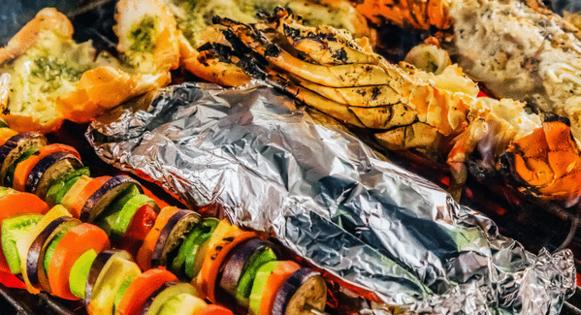Culinary instructor offers tips for making foil grilling packets for Memorial Day
Published in Entertaining
Memorial Day weekend, commemorating fallen military members, also marks the unofficial start to summer. The latter, culinarily, means one thing: It's time to get grilling.
You already know how to toss franks and burgers on the grill, but have you ever tried foil packet cooking? A favorite of Scout troops, these are tidy packages of meat and veggies folded into foil and cooked over the hot coals of a campfire or on the grill. The result is a delicious, satisfying entrée with sides, requiring little or no cleanup.
The idea is similar to sheet pan meals where all the ingredients are baked together in one place. But when the packets are cooked in hot coals, the food picks up the fabulous flavors of smokiness. They're so good.
Cortney Smith, co-owner of Gather Food Studio and Spice Shop, in Colorado Springs, Colorado, teaches the technique to kids during her summer cooking camps. She gave us some tips for getting the job done.
"The best part of foil packet cooking is the fact that once you open your packet, your meal is ready to eat, right out of the foil," she said. "There isn't even a need to dirty plates usually, making them a low-mess, minimal prep camping meal idea."
Here are her suggestions:
— If you're making them for the grill at home, rather than in a campfire, make sure the grill isn't too hot. If it is, it will burn the bottoms of everything in the pack. Shoot for a grill temperature of 350 to 375 degrees.
— Use either heavy-duty foil or a double layer of regular foil. That way, the bottoms won't tear (which would cause the juices to run out).
— Don't stack the ingredients too tall or the middle won't cook evenly. Keep the layers low.
— Fold the edges tight. "I lay out a large rectangle and leave a border so I can fold the foil edges three to four times over the top of the ingredients," Smith said. "This ensures that the steam and juices stay inside the pack for best results."
— Cut meat into small strips or chunks to cook faster. Or pound into a thinner slice of meat.
— For vegetables, cut them into small slices or chunks so that they cook faster.
— An ice cube added to the packet will provide moisture.
— Sauces, such as salsa, BBQ sauce or soy sauce, will also add moisture.
— Salad dressing, melted butter or tomatoes (which naturally contain a lot of moisture) will also work to keep food soft.
— Turn the packet a few times (at least two) to ensure even cooking.
— Always use tongs or oven gloves when touching the packets during and after cooking.
— Mix and match substituting meats, like replacing ground beef with ground chicken or turkey.
"I've watched a fair number of students make foil packs, and they always forget two things," Smith said. "Seasoning (salt, pepper or spices) and adding oil or butter. Make sure that you season before cooking the pack and that you add enough fat to the bottom and the top of the foil pack so that things don't stick. And this will result in a delicious tasting meal."







Comments